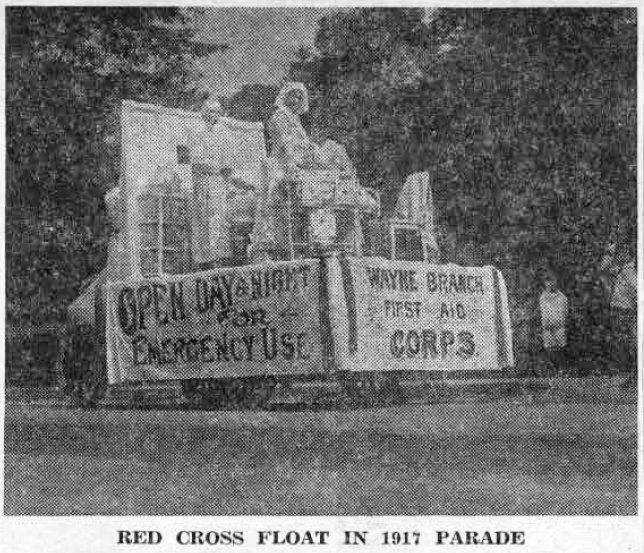 Last week’s column of “Your Town and My Town” described Wayne’s participation in a tremendous Red Cross parade that took place in Philadelphia on June 22, 1917, as part of the “whirlwind campaign” to raise three million dollars for American Red Cross work overseas. Illustrating the column was a picture of one of the Wayne floats used in the parade. A picture of the other float is shown with today’s column.
Last week’s column of “Your Town and My Town” described Wayne’s participation in a tremendous Red Cross parade that took place in Philadelphia on June 22, 1917, as part of the “whirlwind campaign” to raise three million dollars for American Red Cross work overseas. Illustrating the column was a picture of one of the Wayne floats used in the parade. A picture of the other float is shown with today’s column.
According to the graphic description in “The Suburban” of June 29, 1917, this second float illustrated the practical work of the Wayne First Aid room, the pioneer one to be established along the Main Line under Red cross auspices. This room was in the Headquarters at 105 West Lancaster avenue in the house that once stood on the site of the Anthony Wayne Theatre.
A replica of the room was produced for the float shown above. The scene depicted is one that might have taken place following a “reckless joyride” along Lancaster avenue. “The awful example” of the consequences of such a ride is depicted by Mrs. Charles Beatty, who lies on the cot which is almost hidden in the picture by Red Cross nurse Mrs. F.B. Embick. She is helping “Doctor” Lloyd Roberts who is patching up the patient in various places. Standing at the side of the young victim’s cot is his “badly shaken up mother who fortunately seems to have escaped any other damage in the ‘accident’ ”, to quote from “The Suburban” story. In this case the mother was Mrs. Robert Wilson.
The picture was obviously taken in Wayne while the tableau for the float was in rehearsal, as is indicated by the large shade-trees and the hedge. The two small boys standing on the sidewalk have been identified by Miss Roberts as her nephews, William E. Roberts and J. Shipley Troth. It is interesting to note that Mr. Roberts, the “doctor,” left within a short time to go to the U.S. Base Hospital in Nantes, France, where he served as a volunteer for some time.
Marchers on foot from the Wayne Red Cross Branch could not have the honor of escorting their two floats along Broad street, since all floats were massed in a body in the first division of the parade. Said “The Suburban,” “Broad street never saw a more effective sight than the solid column of women in Red Cross uniforms. They extended four city blocks without a break… the effect upon the crowd was remarkable, there was no cheering, only generous applause…
“They were 3,000 earnest Red Cross women marching with but one idea, and that was to help raise the three million dollars Philadelphia owed the Red Cross Fund. Men turned thoughtfully and silently away as the last white rank passed… Many of these men stopped at the Red Cross booths and emptied their pockets into the glass bowl…
“As ‘The Parade,’ it will be known for many a long year after this war is over, when women of the Wayne Branch shall look back with pride and satisfaction to the part they took in the Great War for Country and for the Red Cross.
